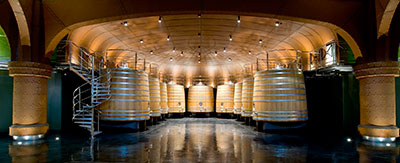
Located in Briones, the winery is part of the large Vivanco Museum of Wine Culture. Manager Rafael Vivanco, who trained as an agricultural engineer and later as a winemaker in Bordeaux, has seen through the project started by his father in the 1980s and has turned Vivanco into a leading Rioja player.
All the grapes used at Vivanco come from their own 300 hectares under vine, spread across the appellation. Finca El Cantillo, named after the large number of stones found on its soil, surrounds the winery. Other vineyards are located in San Vicente, Badarán or Alesón (Rioja Alta) and Villamediana, Agoncillo and Tudelilla (Rioja Baja). Tempranillo and Viura come from Rioja Alta; central areas are planted with Garnacha, Graciano and Mazuelo and the high altitude vines in Rioja Baja are Garnacha, Graciano and Viura.
Since his return from Bordeaux in 2001, Rafael Vivanco has focused his efforts on varieties and terroirs. The winery has been designed to suit his needs: wooden vats for Reservas and top wines; cold rooms, sorting tables and the possibility of doing malolactic fermentations in barrels.
Annual production reaches 1,3 million bottles, most of them of the fresh Crianza (around €8 in Spain). A single varietal Tempranillo from Briones, it spends 16 months in French and oak barrels and shows those vanilla notes so typical of Rioja. Reserva (€13) is made with 5% Graciano and has a production of 250,000 bottles. There is also a Tempranillo rosé with 20% Garnacha (€6.5; 50,000 bottles) and a white made from Viura, Malvasía and 20% Tempranillo Blanco (a red Tempranillo mutation which few wineries in Rioja work with) which costs around €6.5 and has a production of 100,000 bottles.
The “Colección” single-varietal range is the most interesting and includes several wines: a Garnacha (restrained, concentrated, mineral); a Graciano (a wine that needs to develop in the bottle); a Mazuelo (consistent, earthy and with plenty of character) and a Maturana Tinta (a grape with a great future ahead in Rioja due to its ability to provide freshness and vitality). This range is completed with 4 Varietales, which blends most of these grapes with Tempranillo to make a consistent, complex and different red to most of the current offerings in the appellation. Total production of these wines barely reaches 40,000 bottles with prices around €30-44 in Spain.
Dulce de Invierno (€18, 37cl bottle) is the sweet version of 4 Varietales and the result of a late harvest. The mist over the Ebro river helps to botrytise grapes which are usually harvested in January. Earthy notes are followed by toasted and nutty hints in this rare wine.
A new range of wines aimed at millennials was launched on the 2015 vintage with the fun, ground-breaking single-varietal La Maldita Garnacha (125,000 bottles, €7). Grapes are mostly sourced from Tudelilla in Rioja Baja and only 10% of the wine is aged in oak barrels. In the 2016 vintage two other wines were released: a directly pressed rosé (€8) made from grapes from the villages of Badarán (Alto Najerilla) and Briones, and a White Grenache (€8) aged briefly in stainless steel tanks and oak.
Most popular
NEWSLETTER
Join our community of Spanish wine lovers


